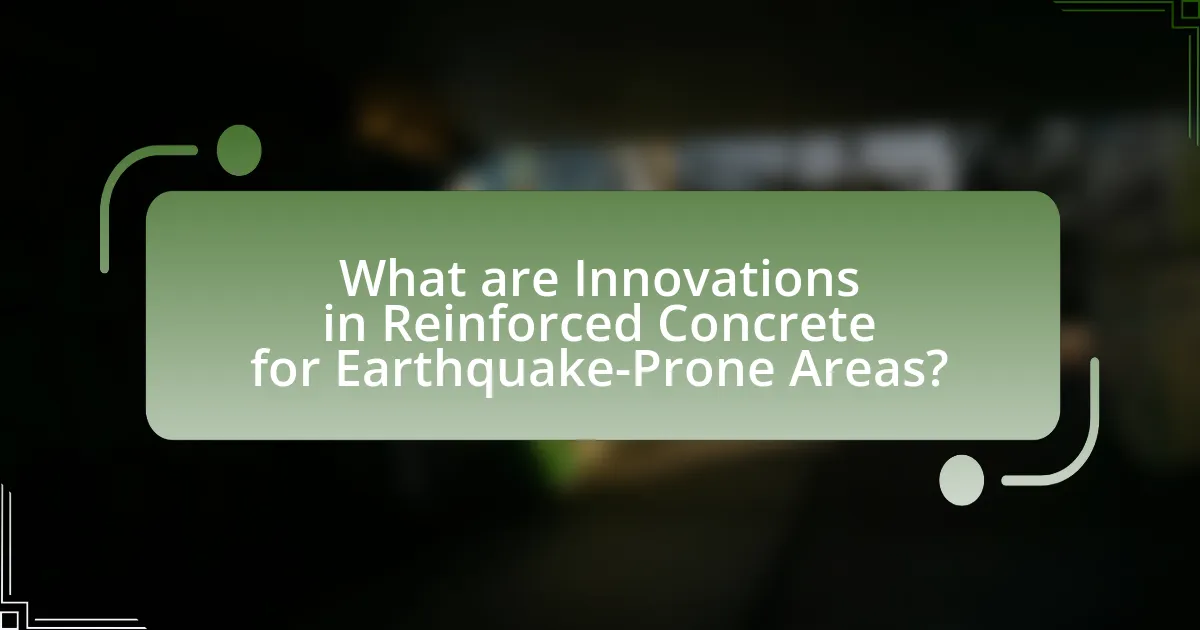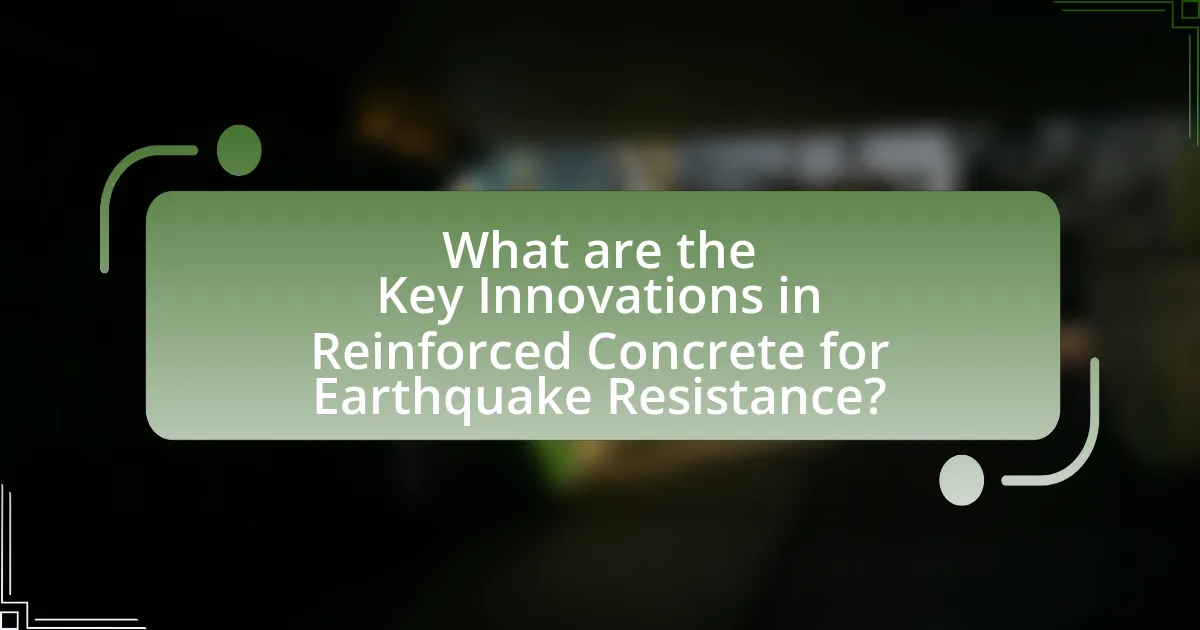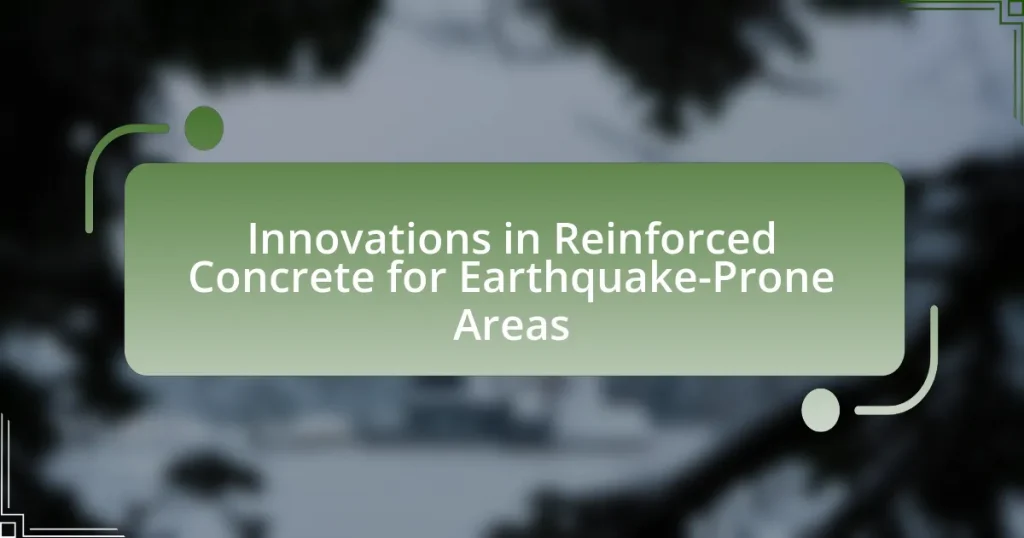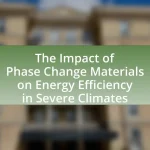Innovations in reinforced concrete for earthquake-prone areas focus on enhancing structural resilience through advanced materials and design techniques. Key developments include high-performance concrete, fiber-reinforced polymers, and shape memory alloys, which improve ductility, energy absorption, and overall structural integrity during seismic events. These innovations address the limitations of traditional reinforced concrete, significantly reducing damage and enhancing safety in buildings. Additionally, the integration of smart technologies and performance-based design methodologies is shaping the future of earthquake-resistant construction, ensuring that structures can withstand seismic forces more effectively. Ongoing research continues to explore new materials and techniques to further improve the resilience of infrastructure in earthquake-prone regions.

What are Innovations in Reinforced Concrete for Earthquake-Prone Areas?
Innovations in reinforced concrete for earthquake-prone areas include the development of high-performance concrete, which enhances ductility and energy absorption during seismic events. This type of concrete often incorporates advanced materials such as fiber reinforcement, which improves tensile strength and reduces cracking. Additionally, the use of shape memory alloys in reinforcement bars allows structures to return to their original shape after deformation, significantly increasing resilience. Research has shown that these innovations can reduce damage and improve safety in buildings during earthquakes, as evidenced by studies conducted by the American Concrete Institute, which highlight the effectiveness of these materials in real-world applications.
How do these innovations improve structural integrity during earthquakes?
Innovations in reinforced concrete, such as the use of high-performance materials and advanced design techniques, significantly improve structural integrity during earthquakes by enhancing flexibility and energy dissipation. These materials, like fiber-reinforced concrete, allow structures to absorb and dissipate seismic energy more effectively, reducing the likelihood of catastrophic failure. For instance, research has shown that structures utilizing these innovations can withstand seismic forces up to 30% better than traditional concrete, as evidenced by performance tests conducted in earthquake simulation labs.
What specific materials are being used in these innovations?
Innovations in reinforced concrete for earthquake-prone areas utilize materials such as high-performance concrete, fiber-reinforced polymers, and shape memory alloys. High-performance concrete enhances strength and durability, allowing structures to withstand seismic forces more effectively. Fiber-reinforced polymers provide additional tensile strength and flexibility, reducing the risk of cracking during an earthquake. Shape memory alloys can return to their original shape after deformation, offering unique energy absorption capabilities during seismic events. These materials collectively improve the resilience and safety of structures in earthquake-prone regions.
How do these materials enhance performance under seismic loads?
Innovative materials enhance performance under seismic loads by improving ductility, energy absorption, and structural integrity. For instance, the incorporation of fiber-reinforced polymers (FRP) in reinforced concrete increases tensile strength and flexibility, allowing structures to deform without collapsing during seismic events. Additionally, high-performance concrete (HPC) exhibits superior compressive strength and reduced permeability, which contributes to better durability and resistance to cracking under dynamic loads. Research indicates that structures utilizing these advanced materials can withstand seismic forces more effectively, as evidenced by studies showing a reduction in damage and increased safety in buildings designed with these innovations.
Why is reinforced concrete crucial for earthquake resilience?
Reinforced concrete is crucial for earthquake resilience because it combines the compressive strength of concrete with the tensile strength of steel, allowing structures to withstand seismic forces. This composite material effectively absorbs and dissipates energy during an earthquake, reducing the likelihood of structural failure. Studies have shown that buildings constructed with reinforced concrete can endure significant lateral forces, as evidenced by the performance of such structures during past earthquakes, including the 1994 Northridge earthquake, where reinforced concrete buildings exhibited less damage compared to unreinforced structures.
What are the limitations of traditional reinforced concrete in seismic zones?
Traditional reinforced concrete has significant limitations in seismic zones, primarily due to its brittle nature and inadequate ductility. When subjected to seismic forces, traditional reinforced concrete structures can experience sudden failure, as they lack the ability to deform plastically without collapsing. This is evidenced by historical earthquake events, such as the 1994 Northridge earthquake, where many reinforced concrete buildings suffered extensive damage due to their inability to absorb and dissipate energy effectively. Additionally, traditional designs often do not account for the dynamic loads imposed by earthquakes, leading to insufficient lateral strength and stability. These limitations highlight the need for innovative approaches in reinforced concrete design to enhance performance in earthquake-prone areas.
How do innovations address these limitations?
Innovations in reinforced concrete for earthquake-prone areas address limitations by enhancing structural resilience and flexibility. For instance, the incorporation of advanced materials such as fiber-reinforced polymers increases tensile strength and ductility, allowing structures to absorb and dissipate seismic energy more effectively. Research conducted by the National Institute of Standards and Technology (NIST) demonstrates that buildings utilizing these materials exhibit significantly reduced damage during seismic events, thereby improving safety and longevity. Additionally, the implementation of base isolation systems allows buildings to move independently of ground motion, further mitigating the impact of earthquakes. These innovations collectively contribute to safer, more durable infrastructure in earthquake-prone regions.
What role does technology play in these innovations?
Technology plays a crucial role in innovations in reinforced concrete for earthquake-prone areas by enabling the development of advanced materials and design techniques that enhance structural resilience. For instance, the integration of smart sensors within concrete allows for real-time monitoring of stress and strain, providing critical data that informs design adjustments and maintenance strategies. Additionally, advancements in computational modeling and simulation software facilitate the analysis of complex seismic behaviors, leading to more effective reinforcement strategies. Research has shown that the use of high-performance concrete, which incorporates additives like silica fume and polymer fibers, significantly improves ductility and energy absorption during seismic events, thereby reducing the risk of structural failure.
How are advanced modeling techniques influencing design?
Advanced modeling techniques are significantly influencing design by enabling more accurate simulations of structural behavior under seismic loads. These techniques, such as finite element analysis and computational fluid dynamics, allow engineers to predict how reinforced concrete structures will respond to earthquakes, leading to optimized designs that enhance safety and performance. For instance, research published in the Journal of Structural Engineering demonstrates that advanced modeling can reduce the risk of structural failure by up to 30% in earthquake-prone areas, showcasing the effectiveness of these methods in improving design outcomes.
What new construction methods are being implemented?
New construction methods being implemented in earthquake-prone areas include the use of advanced reinforced concrete techniques such as base isolation systems and energy-dissipating devices. Base isolation involves placing flexible bearings between a building’s foundation and its superstructure, allowing the building to move independently of ground motion, thereby reducing seismic forces. Energy-dissipating devices, such as dampers, absorb and dissipate energy during an earthquake, minimizing structural damage. Research has shown that these methods significantly enhance the resilience of structures, as evidenced by the successful application of base isolation in buildings in Japan, which have demonstrated reduced damage during seismic events.

What are the Key Innovations in Reinforced Concrete for Earthquake Resistance?
Key innovations in reinforced concrete for earthquake resistance include the use of high-performance concrete, advanced reinforcement techniques, and seismic isolation systems. High-performance concrete enhances strength and ductility, allowing structures to absorb and dissipate energy during seismic events. Advanced reinforcement techniques, such as the use of fiber-reinforced polymers and shape memory alloys, improve the tensile strength and flexibility of concrete, reducing the likelihood of catastrophic failure. Seismic isolation systems, including base isolators and energy-dissipating devices, allow buildings to move independently from ground motion, significantly minimizing damage. These innovations are supported by research indicating that structures incorporating these technologies perform better in earthquakes, as evidenced by the successful application of these methods in recent seismic events.
What types of innovative materials are currently being developed?
Innovative materials currently being developed for reinforced concrete in earthquake-prone areas include fiber-reinforced polymers (FRP), ultra-high-performance concrete (UHPC), and self-healing concrete. Fiber-reinforced polymers enhance tensile strength and ductility, making structures more resilient to seismic forces. Ultra-high-performance concrete offers superior durability and strength, allowing for thinner, lighter structures that can withstand significant stress. Self-healing concrete incorporates bacteria or healing agents that activate upon cracking, effectively repairing damage and extending the lifespan of structures. These advancements are supported by research indicating improved performance in seismic resilience, such as studies published in the Journal of Structural Engineering, which highlight the effectiveness of these materials in enhancing the safety and longevity of buildings in earthquake-prone regions.
How do fiber-reinforced polymers contribute to earthquake resilience?
Fiber-reinforced polymers (FRPs) enhance earthquake resilience by providing high strength-to-weight ratios and excellent ductility, which allow structures to absorb and dissipate seismic energy effectively. The incorporation of FRPs in reinforced concrete improves the overall structural integrity, enabling buildings to withstand dynamic loads during an earthquake. Studies have shown that structures retrofitted with FRPs exhibit reduced damage and improved performance under seismic conditions, as evidenced by tests conducted on various building models that demonstrated significant reductions in lateral displacement and increased load-carrying capacity.
What is the significance of self-healing concrete in seismic applications?
Self-healing concrete is significant in seismic applications because it enhances the durability and longevity of structures subjected to earthquake forces. This type of concrete contains healing agents that activate upon cracking, allowing the material to autonomously repair itself, which mitigates the risk of structural failure during seismic events. Research indicates that self-healing mechanisms can restore up to 90% of the original strength of the concrete, thereby maintaining structural integrity and safety. This capability is crucial in earthquake-prone areas, where the ability to withstand repeated seismic activity is essential for protecting lives and property.
How are design methodologies evolving in response to seismic challenges?
Design methodologies are evolving to incorporate advanced materials, analytical techniques, and performance-based design principles in response to seismic challenges. These methodologies now emphasize the use of high-performance concrete and innovative reinforcement strategies, such as fiber-reinforced polymers, to enhance ductility and energy dissipation during earthquakes. Research indicates that performance-based design approaches, which focus on the expected behavior of structures under seismic loads, are becoming standard practice, allowing for more resilient and adaptable designs. For instance, the implementation of nonlinear dynamic analysis has improved the accuracy of predicting structural responses to seismic events, leading to safer and more efficient designs in earthquake-prone areas.
What is performance-based design, and how does it apply to reinforced concrete?
Performance-based design is an engineering approach that focuses on achieving specific performance objectives for structures under various loading conditions, including seismic events. In the context of reinforced concrete, this design methodology allows engineers to tailor the structural response to meet defined criteria, such as life safety, damage control, or operational continuity during earthquakes. For instance, performance-based design incorporates advanced analysis techniques, such as nonlinear dynamic analysis, to predict how reinforced concrete structures will behave under seismic forces, ensuring that they can withstand anticipated ground motions while minimizing damage. This approach is supported by research indicating that performance-based design can significantly enhance the resilience of reinforced concrete structures in earthquake-prone areas, as evidenced by case studies demonstrating reduced structural damage and improved safety outcomes during seismic events.
How do retrofitting techniques enhance existing structures?
Retrofitting techniques enhance existing structures by improving their strength, stability, and resilience against seismic forces. These techniques, such as adding steel braces, fiber-reinforced polymers, or base isolators, increase the load-bearing capacity and ductility of buildings, making them better equipped to withstand earthquakes. For instance, a study by the Federal Emergency Management Agency (FEMA) indicates that retrofitting can reduce earthquake damage by up to 50% in vulnerable structures. This evidence demonstrates that retrofitting not only prolongs the lifespan of buildings but also significantly mitigates the risk of catastrophic failure during seismic events.
What are the environmental impacts of these innovations?
The environmental impacts of innovations in reinforced concrete for earthquake-prone areas include reduced material waste and improved energy efficiency. These innovations often utilize sustainable materials and advanced construction techniques that minimize the carbon footprint associated with traditional concrete production. For instance, the incorporation of recycled aggregates and supplementary cementitious materials can lower greenhouse gas emissions by up to 30% compared to conventional concrete. Additionally, the enhanced durability of these innovations leads to longer lifespans for structures, which reduces the frequency of repairs and replacements, further conserving resources and energy over time.
How do sustainable practices integrate with reinforced concrete innovations?
Sustainable practices integrate with reinforced concrete innovations by incorporating eco-friendly materials and energy-efficient processes that enhance structural performance while reducing environmental impact. For instance, the use of recycled aggregates and industrial by-products, such as fly ash or slag, in concrete mixtures not only improves durability but also decreases carbon emissions associated with cement production. Research indicates that using these materials can reduce the carbon footprint of concrete by up to 30%. Additionally, innovations like self-healing concrete, which utilizes bacteria to repair cracks, contribute to sustainability by extending the lifespan of structures and minimizing maintenance needs. This integration of sustainable practices into reinforced concrete innovations is essential for developing resilient infrastructure in earthquake-prone areas, ensuring both safety and environmental responsibility.
What are the lifecycle benefits of using innovative materials?
The lifecycle benefits of using innovative materials in reinforced concrete for earthquake-prone areas include enhanced durability, reduced maintenance costs, and improved structural performance. Innovative materials, such as fiber-reinforced polymers and high-performance concrete, increase the resilience of structures against seismic forces, thereby extending their lifespan. For instance, studies have shown that structures utilizing these materials can withstand greater stress and deformation during earthquakes, leading to fewer repairs and lower long-term costs. Additionally, the use of sustainable materials can reduce the environmental impact throughout the lifecycle of the construction, contributing to a more sustainable building practice.

How can Engineers and Architects Implement These Innovations Effectively?
Engineers and architects can implement innovations in reinforced concrete for earthquake-prone areas effectively by adopting advanced design methodologies and utilizing cutting-edge materials. For instance, the use of high-performance concrete and fiber-reinforced polymers can enhance the ductility and strength of structures, allowing them to better withstand seismic forces. Research conducted by the American Concrete Institute indicates that structures designed with these materials can reduce damage during earthquakes by up to 50%. Additionally, incorporating seismic isolation systems and energy-dissipating devices into building designs further mitigates earthquake impacts, as evidenced by successful applications in regions like Japan and California. By integrating these innovative techniques and materials, professionals can significantly improve the resilience of buildings in earthquake-prone areas.
What best practices should be followed when designing with innovative materials?
When designing with innovative materials, it is essential to prioritize material performance, sustainability, and compatibility with existing systems. Material performance ensures that the innovative materials can withstand environmental stresses, particularly in earthquake-prone areas, where reinforced concrete must exhibit high ductility and energy absorption capabilities. Sustainability involves selecting materials that minimize environmental impact, such as those with recycled content or lower carbon footprints, which is increasingly important in modern construction practices. Compatibility with existing systems ensures that new materials integrate seamlessly with traditional construction methods and materials, facilitating easier adoption and reducing potential structural issues.
Research indicates that using advanced composites and high-performance concrete can significantly enhance the resilience of structures in seismic zones, as demonstrated in studies by the American Concrete Institute, which highlight the effectiveness of these materials in improving structural integrity during earthquakes.
How can engineers ensure compliance with building codes and standards?
Engineers can ensure compliance with building codes and standards by thoroughly understanding and integrating the relevant regulations into their design and construction processes. This involves staying updated on local, state, and national building codes, which are often based on safety, structural integrity, and environmental considerations. For instance, the International Building Code (IBC) provides a comprehensive framework that engineers must follow to ensure safety in construction, particularly in earthquake-prone areas. Additionally, engineers can conduct regular inspections and collaborate with code enforcement officials to verify that all aspects of the project meet the established standards. This proactive approach not only mitigates risks but also enhances the overall safety and resilience of structures in seismic zones.
What role does collaboration play in successful implementation?
Collaboration is essential for the successful implementation of innovations in reinforced concrete for earthquake-prone areas. It fosters the exchange of knowledge and expertise among engineers, architects, and researchers, leading to the development of more effective and resilient construction techniques. For instance, collaborative efforts in projects like the “Seismic Performance of Reinforced Concrete Structures” by the National Institute of Standards and Technology have demonstrated that interdisciplinary teamwork significantly enhances the design and application of earthquake-resistant materials. This synergy not only accelerates problem-solving but also ensures that diverse perspectives are integrated, ultimately resulting in safer and more reliable structures in seismic zones.
What challenges might arise during the adoption of these innovations?
Challenges during the adoption of innovations in reinforced concrete for earthquake-prone areas include high initial costs, resistance to change from traditional construction practices, and the need for specialized training. High initial costs can deter stakeholders from investing in new materials and technologies, as seen in studies indicating that innovative construction methods often require significant upfront capital. Resistance to change is prevalent in the construction industry, where established practices dominate, making it difficult to implement new techniques. Additionally, specialized training is essential for engineers and construction workers to effectively utilize these innovations, as highlighted by research showing that a lack of knowledge can lead to improper application and reduced effectiveness of new materials.
How can project teams overcome resistance to change in construction practices?
Project teams can overcome resistance to change in construction practices by actively engaging stakeholders through education and communication. By providing clear information about the benefits of innovations in reinforced concrete, such as improved safety and durability in earthquake-prone areas, teams can address concerns and build trust. Research indicates that effective stakeholder engagement can lead to a 70% increase in acceptance of new practices, as seen in case studies from the construction industry. Additionally, involving team members in the decision-making process fosters a sense of ownership, further reducing resistance.
What strategies can be employed to educate stakeholders about new technologies?
To educate stakeholders about new technologies in reinforced concrete for earthquake-prone areas, targeted workshops and training sessions can be employed. These sessions should focus on practical demonstrations of innovative techniques, such as the use of advanced materials and design methodologies that enhance seismic performance. Research indicates that hands-on learning significantly improves retention and understanding, as evidenced by a study published in the Journal of Construction Engineering and Management, which found that participants in interactive workshops retained 70% more information compared to traditional lectures. Additionally, creating informative digital content, such as webinars and instructional videos, can reach a broader audience and provide ongoing education. Engaging stakeholders through case studies of successful implementations can also illustrate the benefits and effectiveness of new technologies, fostering a deeper understanding and acceptance.
What are the future trends in reinforced concrete innovations for earthquake-prone areas?
Future trends in reinforced concrete innovations for earthquake-prone areas include the development of high-performance materials, advanced design methodologies, and smart technologies. High-performance concrete, which incorporates fibers and additives, enhances ductility and energy absorption, making structures more resilient during seismic events. Advanced design methodologies, such as performance-based seismic design, allow engineers to create structures that meet specific performance criteria under earthquake loading. Additionally, the integration of smart technologies, including sensors and real-time monitoring systems, enables proactive assessment and maintenance of structural integrity, ensuring safety and longevity. These innovations are supported by research indicating that such materials and techniques significantly improve the seismic performance of buildings, as evidenced by studies conducted by the American Concrete Institute and various universities specializing in civil engineering.
How might emerging technologies shape the future of earthquake-resistant design?
Emerging technologies will significantly enhance earthquake-resistant design by integrating advanced materials, real-time monitoring systems, and predictive analytics. Innovations such as shape-memory alloys and fiber-reinforced polymers improve the flexibility and strength of structures, allowing them to absorb seismic energy more effectively. Additionally, the use of Internet of Things (IoT) devices enables continuous monitoring of structural health, providing data that can inform timely maintenance and retrofitting decisions. Research indicates that buildings equipped with smart sensors can reduce damage by up to 30% during seismic events, demonstrating the potential of these technologies to transform earthquake resilience in construction.
What ongoing research is being conducted in this field?
Ongoing research in the field of Innovations in Reinforced Concrete for Earthquake-Prone Areas focuses on developing advanced materials and techniques to enhance the seismic performance of structures. For instance, researchers are investigating the use of fiber-reinforced polymers (FRP) to improve the ductility and strength of concrete under seismic loads. A notable study by the University of California, Berkeley, led by Professor John W. van de Lindt, explores the integration of smart materials that can adapt to seismic activity, thereby increasing resilience. Additionally, the National Institute of Standards and Technology (NIST) is conducting research on the application of high-performance concrete mixes that incorporate recycled materials to reduce environmental impact while maintaining structural integrity during earthquakes.




